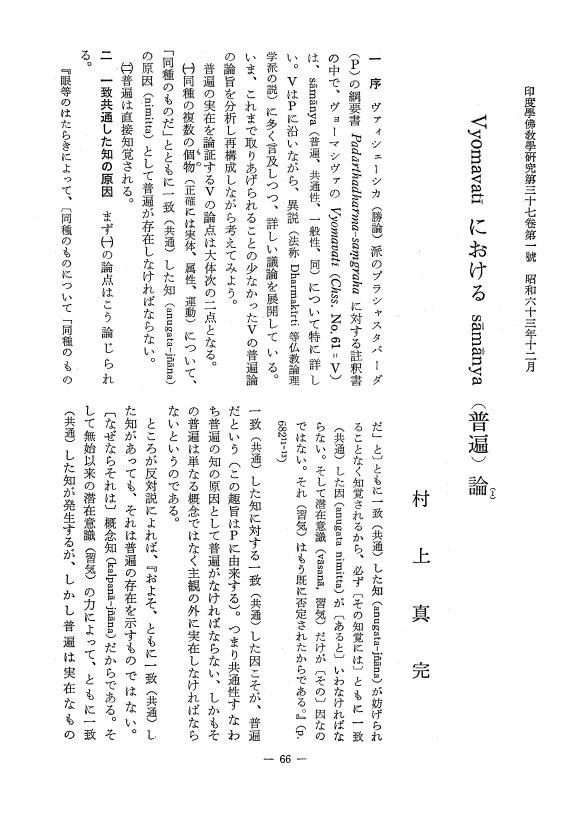10 0 0 0 色(rupa)は物質ではない:――仏典における原意と訳語の考察――
- 著者
- 村上 真完
- 出版者
- 日本印度学仏教学会
- 雑誌
- 印度學佛教學研究 (ISSN:00194344)
- 巻号頁・発行日
- vol.59, no.2, pp.858-851, 2011
3 0 0 0 OA 法(dharma)と存在(bhava)と存在しているもの(sat)
- 著者
- 村上 真完
- 出版者
- 日本印度学仏教学会
- 雑誌
- 印度學佛教學研究 (ISSN:00194344)
- 巻号頁・発行日
- vol.60, no.2, pp.892-885, 2012-03-20 (Released:2017-09-01)
2 0 0 0 OA 色(rupa)は物質ではない ――仏典における原意と訳語の考察――
- 著者
- 村上 真完
- 出版者
- 日本印度学仏教学会
- 雑誌
- 印度學佛教學研究 (ISSN:00194344)
- 巻号頁・発行日
- vol.59, no.2, pp.858-851, 2011-03-20 (Released:2017-09-01)
1 0 0 0 OA 日本仏教における絆の問題:原始仏教との対比
- 著者
- 村上 真完
- 出版者
- 印度学宗教学会
- 雑誌
- 論集 = RONSHU (ISSN:09162658)
- 巻号頁・発行日
- vol.39, 2012-12-31
- 著者
- 村上 真完
- 出版者
- 身延山大学仏教学部チベット学研究室
- 雑誌
- Acta Tibetica et Buddhica (ISSN:18831885)
- 巻号頁・発行日
- no.11, pp.1-98, 2018
- 著者
- 村上 真完
- 出版者
- JAPANESE ASSOCIATION OF INDIAN AND BUDDHIST STUDIES
- 雑誌
- 印度學佛教學研究 (ISSN:00194344)
- 巻号頁・発行日
- vol.45, no.1, pp.427-423, 1996
1 0 0 0 OA Prasantaviniscayapratiharyasutra について
- 著者
- 村上 真完
- 出版者
- JAPANESE ASSOCIATION OF INDIAN AND BUDDHIST STUDIES
- 雑誌
- 印度學佛教學研究 (ISSN:00194344)
- 巻号頁・発行日
- vol.18, no.2, pp.867-871, 1970-03-31 (Released:2010-03-09)
1 0 0 0 OA Niratman と anatman
- 著者
- 村上 真完
- 出版者
- JAPANESE ASSOCIATION OF INDIAN AND BUDDHIST STUDIES
- 雑誌
- 印度學佛教學研究 (ISSN:00194344)
- 巻号頁・発行日
- vol.19, no.2, pp.550-557, 1971-03-31 (Released:2010-03-09)
- 著者
- 村上 真完
- 出版者
- JAPANESE ASSOCIATION OF INDIAN AND BUDDHIST STUDIES
- 雑誌
- 印度學佛教學研究 (ISSN:00194344)
- 巻号頁・発行日
- vol.19, no.2, pp.550-557, 1971
- 著者
- 村上 真完
- 出版者
- 日本印度学仏教学会
- 雑誌
- 印度學佛教學研究 (ISSN:00194344)
- 巻号頁・発行日
- vol.19, no.2, pp.550-557, 1971
1 0 0 0 OA Vyomavati における samanya (普遍) 論
- 著者
- 村上 真完
- 出版者
- JAPANESE ASSOCIATION OF INDIAN AND BUDDHIST STUDIES
- 雑誌
- 印度學佛教學研究 (ISSN:00194344)
- 巻号頁・発行日
- vol.37, no.1, pp.66-72, 1988-12-15 (Released:2010-03-09)
1 0 0 0 Vyomavatiにおけるsamanya(普遍)論
- 著者
- 村上 真完
- 出版者
- 日本印度学仏教学会
- 雑誌
- 印度學佛教學研究 (ISSN:00194344)
- 巻号頁・発行日
- vol.37, no.1, pp.66-72, 1988
1 0 0 0 OA 原始仏教研究法の検討に基づく五蘊説の考察
- 著者
- 村上 真完
- 出版者
- JAPANESE ASSOCIATION OF INDIAN AND BUDDHIST STUDIES
- 雑誌
- 印度學佛教學研究 (ISSN:00194344)
- 巻号頁・発行日
- vol.55, no.2, pp.856-849,1269, 2007-03-20 (Released:2010-07-01)
It is to be reconsidered how to study Early Buddhism. I stress the importance of the text-critical investigations and demonstrations.It seems peculiar to Buddhism from early on that our human existence is analytically grasped as consisting of five aggregates (khandha), i. e. the sensible (rupa), sensation (vedana), conceptual image (sañña), mental and physical latent forces (samkhara) and cognition (viññana). But there are other orders of aggregates. According to the traditions of the Vedanta, i. e., Sankara and others (ad Brahma-sutra 2.2.18) the order is rupa-vijñana-vedana-samjña-samskara, and according to Jaina-tradition, i. e., Haribhadra-suri (Saddarsana-samuccaya 1.5) it is vijñanam vedana samjña samskaro rupam. Harivarman's Chengshi lun 成実論 (vol. 3, T. 32, No. 1646, 261a7-) which was translated by Kumarajiva in 412 enumerates rupa-vijñana-samjña-vedana-samskara. In the fifth century Buddhaghosa in his Visuddhimagga (PTS ed. 45215-) explained the five aggregates in the same order as that of Sankara's enumeration. So Sankara and others must have had some credible Buddhist sources.I investigate original and developed meanings of each of the five aggregates, and lastly consider the original and developed meaning of nama-rupa (name and form) which is looked upon as the cause (samudaya) of cognition (viññana) It means originally name and personal looks, then mind and body, and is explained as being composed of five aggregates or four aggregates except cognition.
1 0 0 0 原始仏教研究法の検討に基づく五蘊説の考察
- 著者
- 村上 真完
- 出版者
- 日本印度学仏教学会
- 雑誌
- 印度學佛教學研究 (ISSN:00194344)
- 巻号頁・発行日
- vol.55, no.2, pp.856-849,1269, 2007
It is to be reconsidered how to study Early Buddhism. I stress the importance of the text-critical investigations and demonstrations.<br>It seems peculiar to Buddhism from early on that our human existence is analytically grasped as consisting of five aggregates (<i>khandha</i>), i. e. the sensible (<i>rupa</i>), sensation (<i>vedana</i>), conceptual image (<i>sañña</i>), mental and physical latent forces (<i>samkhara</i>) and cognition (<i>viññana</i>). But there are other orders of aggregates. According to the traditions of the Vedanta, i. e., Sankara and others (ad <i>Brahma-sutra</i> 2.2.18) the order is <i>rupa-vijñana-vedana-samjña-samskara</i>, and according to Jaina-tradition, i. e., Haribhadra-suri (<i>Saddarsana-samuccaya</i> 1.5) it is <i>vijñanam vedana samjña samskaro rupam</i>. Harivarman's <i>Chengshi lun</i> 成実論 (vol. 3, <i>T</i>. 32, No. 1646, 261a<sup>7-</sup>) which was translated by Kumarajiva in 412 enumerates <i>rupa-vijñana-samjña-vedana-samskara</i>. In the fifth century Buddhaghosa in his <i>Visuddhimagga</i> (PTS ed. 452<sup>15-</sup>) explained the five aggregates in the same order as that of Sankara's enumeration. So Sankara and others must have had some credible Buddhist sources.<br>I investigate original and developed meanings of each of the five aggregates, and lastly consider the original and developed meaning of <i>nama-rupa</i> (name and form) which is looked upon as the cause (<i>samudaya</i>) of cognition (<i>viññana</i>) It means originally name and personal looks, then mind and body, and is explained as being composed of five aggregates or four aggregates except cognition.




